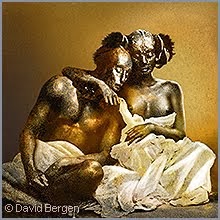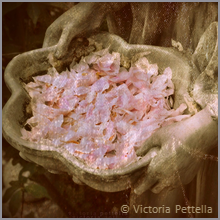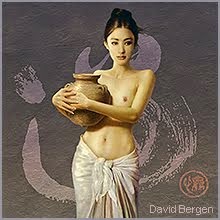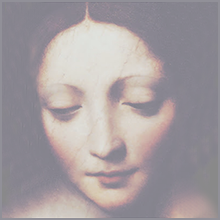
The Lowlands in 1430 brought a year of terrible storms. The gales were so strong that parts of the dykes which protected West Friesland were breached, and the North Sea broke through and flooded the farmlands. But these storms were not all that were brought to the country. Among the many fish left stranded on the farmlands was (if we believe the wondering accounts written at the time) a mermaid.
A group of women gathering the stranded fish for an easy meal apparently discovered the unfortunate creature floundering in the shallow waters. Astonished (as well they might be), they somehow managed to carry the marvel to dry land, where she was eventually transported to the city of Edam, and from Edam to the city of Haarlem.
The Mermaid of Haarlem, as she became known, was provided with good Christian clothes with which to suitably cover her heathen nakedness, and seems to have settled down to this new life away from her watery home. She also seems to have adapted her diet to one of cooked meat, and was taught to spin yarn, and to pray and to make the sign of the crucifix. In short: the mermaid was provided with the essentials for a life in the Christian community in which she now found herself.
But these outward trappings of her surroundings do not seem to have erased her essential nature. Apparently she always retained a longing for her watery home, and every attempt to teach her even the essentials of human language resulted only in stubborn silence. How many years she spent as a half-reluctant member of her adopted community is not recorded, although we are told that on her death she was given a full Christian burial. Ah: if only we knew of her burial place! Would an exhumation reveal a marvel, or merely a prosaic disappointment?
Almost six centuries is a long time: long enough for us to wish that the story of the Haarlem Mermaid might just be true: long enough for us to hope that the story perhaps has a grain of substance. We seem to need mermaids and other fantastic creatures, but what perhaps touches us about her story is the notion of exile.
Let us suppose (because it is what we would like to believe) that the story is true. Did the mermaid truly have some sense of Christian reverence when she crossed herself, or was she merely mimicking the actions of those around her? And how strangely alien and awkward the wearing of clothes must at first have seemed to her. And what apparently was her resistance to human speech might have been more to do with her inability to speak at all, for who knows the ways in which mermaids communicate with each other when swimming in their watery home?
What we recognize in the mermaid’s story is the wish, however misplaced, to want to change someone to be like ourselves. We resist that ‘otherness’ which makes someone special, which makes them the unique individual that they truly are. We want someone to share our own beliefs, because that is a way of confirming to ourselves that the things in which we believe must be ‘right’. We misguidedly imagine that we can ‘improve’ someone by persuading them to believe what we believe, and to think as we think.
But is such persuasion a form of conversion, or a form of possession? We might excuse the actions of her captors towards the mermaid as belonging to the attitudes of 15th-century Catholic Europe, but such attitudes persist. Mormons or Jehovah’s Witnesses who come knocking on your door are in their intention no different from the goodwives of Haarlem who taught the mermaid how to make the sign of the cross.
‘To thine own self be true’. But the mermaid was a unique being among many foreign souls, and social pressures can be hard to resist. Perhaps we can begin by recognizing and respecting each individual in her or his own right, whatever beliefs she or he might hold – whether human or mermaid.
Painting: Oceanid by Annie Louisa Swynnerton






















.png)
















Thank you for this wonderful story of the Mermaid of Haarlem. It is engagingly written with much sensitivity and thoughtful reflection. I truly enjoyed reading it! And the painting is stunning is apt partner to the story. The story could have several layers of meaning, for example honoring one's true nature versus societal pressures to conform, or the analogy of spirit lost in the 'earthly' form dimension yearning its return to home. Emma's contemplation of some people wish to change others, to convert them, to some desired belief is what I find thought provoking and worthy of contemplation. "We misguidedly imagine that we can ‘improve’ someone by persuading them to believe what we believe, and to think as we think." I was raised Christian although now I no longer confine myself to any system of religion or philosophy. However, one of the fundamental paradigms of how I was raised what this question, "What do you believe?" This question was paramount, as the answer could be the difference between heaven or eternal damnation. What an incredibly serious choice! Now I realize fully that the whole premise to this question was flawed. We place too much emphasis on 'belief.' Belief is just an imagined image or thought that one does not really know is true but for some good reason like the fear of hell fire one has to make oneself believe that the imagined thought to be absolute truth. And when there is a group of people insisting on the same belief then it becomes a powerful force of persuasion. However, it does not mean that the imagined thought is true. People can be very blinded by their beliefs, assumptions and opinions, to the extent that they no longer see the beauty and marvel of the Mermaid, but only see their desire to paint everything in the exact same colors they are wearing. This is a form of delusion. So as Emma points out perhaps we can place a little more awareness in the our beliefs, assumptions and opinions and realize that they are not reality, they are just thoughts. Perhaps then we can see the beauty of the Mermaid in us and in others.
ReplyDeleteJoseph, thank you for all the extra insights which you provide. As you suggest, I did indeed have in mind the experience of an earthly incarnation being reflected in the mermaid's story. There are reasons why such stories tug at us so powerfully, and many such universal truths and experiences are, I am sure, the underlying reason. That central question "What do you believe?" can have so much pressure behind it! As your own experience points out, so much of that pressure has to do with fear: the fear you are made to feel about what will happen to you if you don't 'believe'. A belief in Heaven and Hell become a way of controlling what we believe through fear, and such ideas can be very persuasive if we find ourselves in a social group that supports them. I think you are also right when you say that we so easily become blinded by our beliefs - and the more blind we allow ourselves to become, the more we shut ourselves off to discovering and seeing all the beautiful uniqueness in others, and to simply accept them for who they truly are.
DeleteThank you Emma for your insightful comments. I must simply laugh at my own writing - I wrote my comment above rather quickly and did not proof read it. Now I see so many errors, but you so graciously understood what I was trying to express!
ReplyDeleteNow you make my laugh, dear Joseph. I would be the last to mind any mistake on your part, since you always so graciously overlook mine when we correspond. ♥
Delete